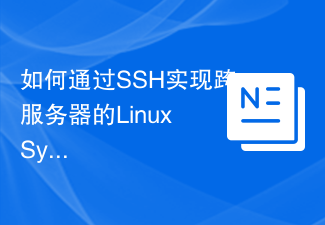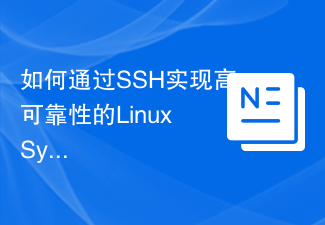 Operation and Maintenance
Operation and Maintenance Linux Operation and Maintenance
Linux Operation and Maintenance Linux SysOps SSH connection speed optimization tips
Linux SysOps SSH connection speed optimization tips
Linux SysOps SSH connection speed optimization tips
SSH (Secure Shell) is a network protocol used to securely execute remote commands and Transfer files. As Linux system operation and maintenance personnel, we often need to use SSH to remotely connect to the server for management and maintenance. However, sometimes we may encounter the problem of slow SSH connection speed, which will affect our work efficiency. This article will introduce some tips for optimizing SSH connection speed and provide specific code examples.
- Using the SSH configuration file
The SSH configuration file is located in /etc/ssh/sshd_config, where you can set some parameters to optimize the SSH connection speed. The following are some commonly used configuration options:
- TCPKeepAlive: This option controls whether to send TCP keepAlive packets to keep the SSH connection active. Setting this to "yes" improves connection speed and reduces the likelihood of disconnections.
TCPKeepAlive yes
- ClientAliveInterval and ClientAliveCountMax: These two options are used to detect idle connections and automatically disconnect them. The default interval is 0, which means this feature is disabled. ClientAliveInterval can be set to a certain interval (such as 60 seconds), and ClientAliveCountMax can be set to a certain number of times (such as 3 times) to keep the SSH connection active.
ClientAliveInterval 60 ClientAliveCountMax 3
- UseDNS: If the DNS service is not enabled in your network environment, you can set UseDNS to "no" to speed up the SSH connection.
UseDNS no
- Compression: Enabling data compression reduces the amount of data transferred, thereby increasing connection speeds. However, if your network has a lot of bandwidth, you may not need to enable this option.
Compression yes
- Using SSH Agent Forwarding
SSH Agent Forwarding is a function that passes the SSH key on the local computer to the remote server, which can avoid multiple Enter your password once. Before using SSH Agent Forwarding, you need to ensure that the local computer has been configured with an SSH key.
On your local computer, just run the following command:
ssh-add
Then connect to the remote server via SSH. This avoids entering a password every time you connect and improves connection speed.
- Use connection reuse
SSH connection reuse refers to creating a new session on an already established SSH connection without having to re-authenticate and establish a new one. connect. This can reduce the connection establishment time and increase the connection speed. You can add the following options to the SSH configuration file to enable connection reuse:
ControlMaster auto ControlPath ~/.ssh/socket-%r@%h:%p
- Adjust SSH encryption algorithm
By default, the encryption algorithm used by SSH is somewhat slow , the encryption algorithm can be adjusted to increase connection speed. In the SSH configuration file, the following options can be added or modified to a suitable encryption algorithm:
Ciphers aes128-ctr,aes192-ctr,aes256-ctr MACs hmac-sha2-512,hmac-sha2-256 KexAlgorithms diffie-hellman-group-exchange-sha256
- Optimize server-side configuration
On the server side, you can use the following methods To optimize SSH connection speed:
- Disable GSSAPI authentication: GSSAPI authentication can be disabled by adding the following configuration option to the SSHD configuration file.
GSSAPIAuthentication no GSSAPICleanupCredentials no
- Limit the maximum number of connections: By limiting the maximum number of concurrent connections to the SSH server, you can reduce CPU and memory usage, thereby increasing connection speed.
MaxSessions 10
Summary:
Through the above optimization techniques and configuration examples, we can significantly improve the SSH connection speed, reduce unnecessary waiting time, and thus improve work efficiency. However, different environments and needs may require different optimization strategies, and it is recommended to adjust and test according to the actual situation.
Note: Before making any configuration changes, please ensure a backup of all configuration files and test whether the new configuration is working properly.
The above is the detailed content of Linux SysOps SSH connection speed optimization tips. For more information, please follow other related articles on the PHP Chinese website!
 教你在Linux SysOps中使用SSH进行文件传输Sep 26, 2023 pm 03:58 PM
教你在Linux SysOps中使用SSH进行文件传输Sep 26, 2023 pm 03:58 PM教你在LinuxSysOps中使用SSH进行文件传输,需要具体代码示例SSH(SecureShell)是一种加密的远程登录协议,它不仅可以用于远程登录操作系统,还可以用于在不同的主机之间进行文件传输。在LinuxSysOps工作中,经常需要使用SSH进行文件传输,这篇文章将为你提供具体的代码示例,教你如何在Linux环境中使用SSH进行文件传输。首先,
 网络唤醒和关机连接速度对网络效率有何影响Feb 18, 2024 am 11:38 AM
网络唤醒和关机连接速度对网络效率有何影响Feb 18, 2024 am 11:38 AM随着科技的发展,网络已经成为了人们日常生活中不可或缺的一部分。在网络的世界中,人们可以随时随地地获取信息、交流、娱乐等。然而,网络的连接速度一直是人们所关注的一个重要问题。特别是在网络唤醒和关机这两个方面,连接速度尤为重要。那么,网络唤醒和关机连接速度有什么用呢?本文将会对此进行阐述。首先,网络唤醒的连接速度对于提高工作效率非常重要。在工作中,我们经常需要将
 Linux SysOps SSH连接速度优化技巧Sep 26, 2023 pm 01:40 PM
Linux SysOps SSH连接速度优化技巧Sep 26, 2023 pm 01:40 PMLinuxSysOpsSSH连接速度优化技巧SSH(SecureShell)是一种网络协议,用于在不安全的网络上安全地执行远程命令和传输文件。作为Linux系统运维人员,我们经常需要使用SSH来远程连接服务器进行管理和维护。然而,有时候我们可能会遇到SSH连接速度较慢的问题,这会影响我们的工作效率。本文将介绍一些优化SSH连接速度的技巧,并提供具体的代
 SSH密钥对在Linux SysOps中的配置与管理方法Sep 27, 2023 pm 02:45 PM
SSH密钥对在Linux SysOps中的配置与管理方法Sep 27, 2023 pm 02:45 PMSSH密钥对在LinuxSysOps中的配置与管理方法在Linux系统运维(SysOps)中,SSH(SecureShell)是一种常用的远程登录和管理工具。而SSH密钥对的配置与管理是保证连接安全性和简化登录过程的重要一环。本文将介绍SSH密钥对的配置与管理方法,并提供具体的代码示例。SSH密钥对通常由公钥(publickey)和私钥(private
 如何通过SSH实现跨服务器的Linux SysOps管理Sep 28, 2023 am 11:04 AM
如何通过SSH实现跨服务器的Linux SysOps管理Sep 28, 2023 am 11:04 AM如何通过SSH实现跨服务器的LinuxSysOps管理概述:在Linux系统管理中,经常需要同时管理多台远程服务器。通过SSH(SecureShell)协议,我们可以实现跨服务器的管理操作。本文将介绍如何使用SSH实现跨服务器的LinuxSysOps(系统运维)管理,并提供具体的代码示例。SSH简介:SSH是一种加密的远程登录协议,它可以通过安全通道在
 Linux SysOps SSH教程:一步步学习如何进行远程服务器管理Sep 26, 2023 pm 01:18 PM
Linux SysOps SSH教程:一步步学习如何进行远程服务器管理Sep 26, 2023 pm 01:18 PMLinuxSysOpsSSH教程:一步步学习如何进行远程服务器管理,需要具体代码示例引言:SSH(SecureShell)是一种通过网络进行远程登录和安全数据传输的协议。对于Linux系统管理员(SysOps),熟练掌握SSH的使用是至关重要的。本文将介绍SSH的基本概念,以及如何使用SSH进行远程服务器管理的步骤,并提供具体的代码示例。SSH基础知识
 SSH原理解析及在Linux SysOps中的应用Sep 27, 2023 pm 12:49 PM
SSH原理解析及在Linux SysOps中的应用Sep 27, 2023 pm 12:49 PMSSH原理解析及在LinuxSysOps中的应用引言SSH(SecureShell)是一种网络协议,用于在不安全的网络中提供安全的远程登录和文件传输功能。在Linux系统运维(SysOps)中,SSH是一种非常常用的工具,可以提供安全可靠的远程管理方式。本文将解析SSH的原理,并介绍SSH在LinuxSysOps中的常见应用场景,并提供一些具体的代码示
 如何通过SSH实现高可靠性的Linux SysOps架构设计Sep 26, 2023 am 09:43 AM
如何通过SSH实现高可靠性的Linux SysOps架构设计Sep 26, 2023 am 09:43 AM如何通过SSH实现高可靠性的LinuxSysOps架构设计引言:在当今科技快速发展的时代,Linux操作系统作为一种高性能、高可靠性的系统,被广泛应用于各行各业。随着企业对系统可靠性要求的不断提高,设计一套高可靠性的LinuxSysOps架构变得尤为重要。本文将介绍如何通过SSH实现高可靠性的LinuxSysOps架构设计,并提供具体的代码示例。一、什


Hot AI Tools

Undresser.AI Undress
AI-powered app for creating realistic nude photos

AI Clothes Remover
Online AI tool for removing clothes from photos.

Undress AI Tool
Undress images for free

Clothoff.io
AI clothes remover

AI Hentai Generator
Generate AI Hentai for free.

Hot Article

Hot Tools

ZendStudio 13.5.1 Mac
Powerful PHP integrated development environment

MinGW - Minimalist GNU for Windows
This project is in the process of being migrated to osdn.net/projects/mingw, you can continue to follow us there. MinGW: A native Windows port of the GNU Compiler Collection (GCC), freely distributable import libraries and header files for building native Windows applications; includes extensions to the MSVC runtime to support C99 functionality. All MinGW software can run on 64-bit Windows platforms.

Notepad++7.3.1
Easy-to-use and free code editor

VSCode Windows 64-bit Download
A free and powerful IDE editor launched by Microsoft

SAP NetWeaver Server Adapter for Eclipse
Integrate Eclipse with SAP NetWeaver application server.




